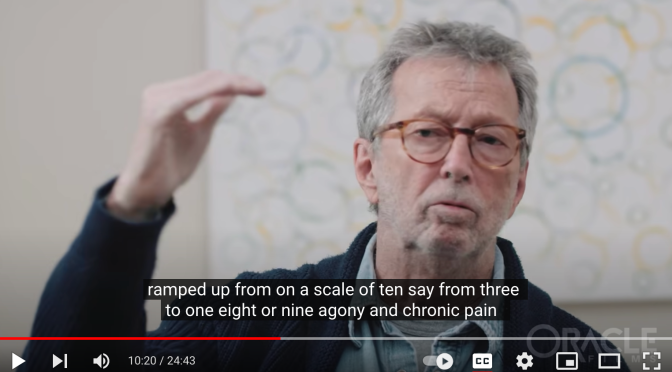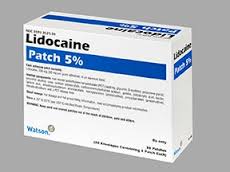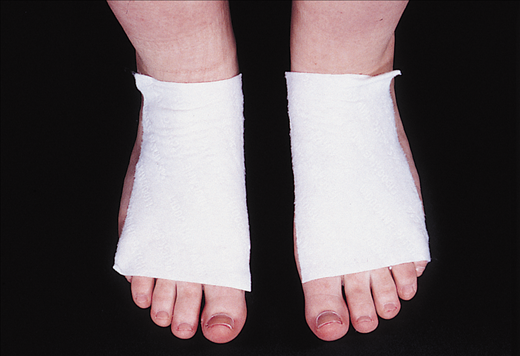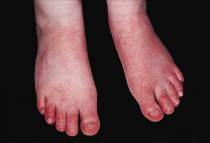Source of Featured Image
“… ramped up from, on a scale of ten, say, from 3 to … 8 or 9 … Agony and chronic pain …”
(Go to 10:20 minutes for screenshot.)
Please note: The advertisements are NOT mine.
Dear Pain Matters readers,
Sadly, countless people suffer from severe adverse reactions including chronic pain following their experimental Covid mRNA injections including famous musician, Eric Clapton.
Quoting Eric Clapton in an interview with Robin Monotti, Italian architect and film producer, regarding his adverse reaction to the AstraZeneca injection:
“I can’t sleep because of the pain … the vaccine took my immune system and just shook it around …
… and I went and had the jab and I got a little green [card] (like a library card), and I thought that’s what I’m going to show the people when I get on the plane. … Within several hours, I was shaking like a leaf and I went to bed early and I couldn’t get warm … I thought … am I running a fever? I was boiling hot and sweating, and then I was cold. … I was out for the count for about a week.
I had been preparing for a project where I was going to be playing acoustic guitar with a couple of musicians and we were going to film it that week. Knocked me out and I had to start again from scratch. … It didn’t come off as well as I would like to … It was a huge setback and it frightened the **** out of me because I didn’t know how long it would last. I then started to find out more …
… bit by bit, I realised that I probably shouldn’t have had the first jab but then I was offered the second [jab]. I thought, well, … what’s the point in … stopping now? So I went and had the second [jab], … And then it got really bad and within about a week, I had lost my hands – [they] didn’t really work. … I suffered from a condition … called peripheral neuropathy, which is nerve damage pain, … which means that … I can get numb, or pins and needles. …
This [pain] … ramped up from, say, 3 to … 8 or 9 (on a scale of 10). Agony and chronic pain … I have gigs to do, I have recording work to do, but I can’t … play the guitar, it’s not fun and it’s something I do … then when I put [the guitar] down, [the pain] is there until I go to bed. I take sleeping pills because I can’t sleep because of the pain, and that’s … not a good way to live … the vaccine took my immune system and just shook it around again, and that’s still going on …
… and I called my … NHS doctor after the second jab and I said, “I’ve been told there’s a yellow card system … where I can complain about after-effects?“ He said … , “I’ll fill in the report …” …
I lost the use of my hands for about 3 weeks, so I thought I was in real trouble. That’s about that point I was invited by Robin Monotti to talk about it … because I realised that … I wasn’t the only one that was suffering adverse reactions … I can’t touch anything cold or hot, I have to use these [gloves], otherwise my hands will begin to burn and they’ll stay burnt all day.
… that’s my experience from having had the second jab … I went to my doctor … and said, you know, I can’t have any more vaccinations. This is not possible for me because I don’t know what will happen. I don’t know what will happen next. …”
Source:
Eric Clapton: Exclusive & Uncensored Oracle Films – Robin Monotti in conversation with Eric Clapton
(24 minutes; transcript available; 14 June 2021; 492,000 views)
https://www.youtube.com/watch?v=4OHmMKrVbNk
via https://t.me/robinmg/26449
Quoting Eric Clapton in another interview with Robin Monotti:
“In February [2021] this year, before I learned about the nature of the [Covid] vaccines and being 76 with emphysema, I was in the avant garde. I took the first jab of [AstraZeneca] and straight away, [I] had severe reactions which lasted 10 days, I recovered eventually and was told it would be 12 weeks before the second one…
About 6 weeks later, I was offered and took the second [AstraZeneca] shot, but with a little more knowledge of the dangers. Needless to say, the reactions were disastrous. My hands and feet were either frozen, numb or burning, and pretty much useless for 2 weeks. I feared I would never play again. I suffer with peripheral neuropathy and [I] should never have gone near the needle. But the propaganda said the vaccine was safe for everyone. …”
Source:
Robin Monotti: A Conversation with Eric Clapton | Oracle Films
(22-minutes; transcript available; 16 June 2021)
via https://t.me/robinmg/3377,
Thank you very much, Robin Monotti, for sharing Eric Clapton‘s experiences that will hopefully help others struggling with side effects including chronic pain, post-Covid injection.
In closing today, I leave you with 2 songs by Eric Clapton, one written in 2021 and the second one written in 1992. Like so many of his songs, the lyrics to these songs are laden with meaning hence worthwhile analysing in greater detail:
This Has Gotta Stop
…
I knew that somethin’ was goin’ on wrong
When you started layin’ down the law
I can’t move my hands, I break out in sweat
I wanna cry, can’t take it anymore
…
I’ve been around long, long time
Seen it all, and I’m used to being FREE
I know who I am, try to do what’s right
So lock me up and throw away the key
This has gotta stop
Enough is enough
I can’t take this BS any longer
It’s gone far enough
If you wanna claim my soul
You’ll have to come and break down this door
Tears In Heaven
https://www.youtube.com/watch?v=JxPj3GAYYZ0
Sabina Walker
Master in Applied Science (Neuroscience)
Blogger, Pain Matters
ADDITIONAL REFERENCES
(1) Eric Clapton: I should never have gone near the needle.
(3) Makis, William MD
Musicians Injured – Eric Clapton: “I can’t sleep because of the pain … the vaccine took my immune system and just shook it around” –
Eric Clapton bravely discusses his neurological COVID-19 vaccine injuries (11 February 2023)
https://makismd.substack.com/p/eric-clapton-i-cant-sleep-because



